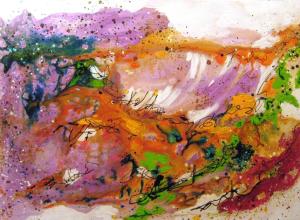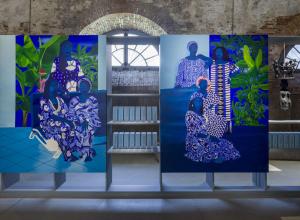The Yale University Art Gallery is pleased to present an installation of twenty-seven pieces of Texas silver lent by Houston businessman and philanthropist William J. Hill. The silver will be on view through December 10, 2017, in the museum’s gallery devoted to the arts of New France, New Spain, and Texas, on the first floor of Street Hall. Hill has been an enthusiastic collector of Texas-made objects and a generous donor of Texas-made furniture, ceramics, and other works of art to the Gallery, some of which are shown alongside the silver.
The history of the territory that became the state of Texas is complex. Spanish conquistadors arrived in Texas in the 16th century, and by the late 17th century the Spanish had established an outpost at El Paso. At the same time, France was vying with Spain over control of the land in the Mississippi Valley, including the area called Texas. When Mexico won its independence from Spain in 1821, Texas became part of Mexico. Following a revolt against the Mexican government in 1835 to 1836, Texas became a republic, although Mexico did not recognize it. The United States annexed Texas as a state in 1845, and at the conclusion of the Mexican-American War in 1848, Mexico acknowledged its independence. In 1861 Texas seceded from the United States to join the Confederate States of America. In the period of the republic and early statehood, Texas’s rich land, suitable for cotton culture and ranching, attracted immigrants drawn overwhelmingly from southern slaveholding states as well as from Germany. Among the immigrants who relocated to Texas was the silversmith Samuel Bell, who came to San Antonio from Knoxville, Tennessee, in 1851 and established a silversmithing dynasty there. Just two years later, in 1853, F. S. Adolph Bahn, a German immigrant, established a silversmithing shop in Austin.
Objects in the Hill collection have tangible links to the early history of Texas. Three of the early vessels in the collection are latter-day examples of 18th-century camp cups used in military settings, such as the famous set Richard Humphreys of Philadelphia made for George Washington in 1780. One such vessel—made by the aforementioned silversmith Samuel Bell between 1851 and 1860—is a cup engraved “Capt Alfred Gibbs / USA [United States Army]”. West Point–educated Alfred Gibbs (1823–1868) served with distinction in the Mexican-American War, was subsequently appointed commander of the United States Army’s Department of Texas, and then fought with the Union army during the Civil War.
After the successful conclusion of the Mexican-American War, the United States Army needed a presence in Texas to secure the vast new territory that was inhabited by hostile Indians, particularly the Comanche. The Second United States Cavalry was established to deal with this problem, and West Point graduate Andrew Parker Porter (1835–1866) served in that unit as a second lieutenant participating in Indian scouting missions. A tumbler made by Bell and engraved “APP USA” no doubt was Porter’s and could have been acquired in San Antonio and used by the lieutenant between 1856 and 1861 at his postings in Camp Colorado, Fort Chadbourne, Camp Radziminski, Fort Mason, and then Fredericksburg, all in Texas. With the beginning of the Civil War, Porter returned east to fight in the Union army. A related tumbler also on view is engraved “A. W. Terrell” and was made by F. S. Adolph Bahn, in Austin, Texas, for Alexander W. Terrell (1827–1912), a Virginia-born Austin lawyer who was a colonel during the Civil War with the 37th Regiment Texas Cavalry.
In addition to silver made by silversmiths of Anglo and Germanic heritage, the Hill collection also features flatware by a maker of Hispanic origin. Silversmiths with Hispanic names are known to have worked in Texas, but little silver by them has been identified. A spoon with unusual thickening of the handle shaft at the junction with bowl is marked RAMZ.” and has a spread-wing eagle within a rectangle with canted corners, possibly for an as-yet-unidentified silversmith named Ramirez, who may have worked in the El Paso area.
Silver made in Texas tends to be heavier and of thicker gauge than silver made in the east and retailed in Texas. About half of the Hill collection is made up of the latter such work, including pieces with manufacturers’ marks of the Gorham Manufacturing Company, of Providence, Rhode Island, as well as Wood and Hughes and the Whiting Manufacturing Company, both of New York. This phenomenon was not unique to Texas; throughout the United States from at least the beginning of the 19th century, small silversmiths’ shops made less of their own wares and became retail outlets for silver produced by larger operations.
The most elaborately ornamented object in the collection is the cup by Bell and Brothers with engraved borders and cartouche in the Néo-Grec style. The cartouche frames the inscription “John A. Fraser, Jr. / from / Aunt Clara / Jan. 6th 1879.” The cup was likely for a son born to John A. Fraser (1842–1930) and his wife, Zelime Tobin, who were married in 1878. Although records for the birth and death of that John A. Fraser have not been found, the couple had another son, John A. Fraser, Jr., born on June 2, 1880. The elder Fraser was a banker and the younger Fraser became a merchant with land interests in Mexico. Thus, by the last quarter of the 19th century, about 30 years after the first silver was being made in Texas for figures involved in taming the frontier, Texans like the Frasers lived prosperous and genteel lives and had silver objects to complement that lifestyle.
The William J. Hill Artisans and Artists Archive
Houston-based collector and philanthropist William J. Hill has a long-standing commitment to the study and appreciation of nineteenth-century Texas culture. He has supported the development of an online database of Texas material culture at Bayou Bend Collection and Gardens, part of the Museum of Fine Arts, Houston. The database, called the William J. Hill Artisans and Artists Archive, is available at http://texasartisans.mfah.org/.


























